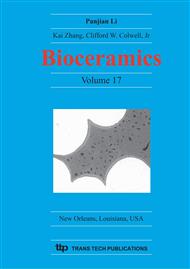p.585
p.589
p.593
p.597
p.603
p.607
p.611
p.615
p.619
Culturing Human Mesenchymal Stem Cells on Bioceramics for Hard Tissue Regeneration (Validation of In Vitro Bone Matrix Formed on Ceramics for Clinical Application)
Abstract:
Alumina ceramics have excellent mechanical and biocompatible properties, but are bioinert and hence have no bone-bonding properties. We took a tissue engineering approach in an attempt to modify the ceramic surface and so provide an osteogenic/osteoconductive milieu. We used fresh human bone marrow cells obtained from the iliac crest by needle aspiration for culture expansion of mesenchymal stem cells (MSC) followed by in vitro osteogenic differentiation on both tissue culture polystyrene (TCPS) and alumina ceramics. We have succeeded in expanding the number of MSC from all 35 cases and compared the differentiation capability of selected MSC on alumina ceramics to that on TCPS. The cells on both substrata showed extensive alkaline phosphatase staining and mineralization as evidenced by calcein uptake. Biochemical analyses revealed high levels of alkaline phosphatase activity, osteocalcin expression, and calcium content. These data indicate that an alumina ceramic surface can support a differentiation cascade of MSC resulting in osteoblastic phenotype expression of the cells. Based on these results, we have performed clinical applications of tissue engineered total joint replacements for osteoarthritic patients.
Info:
Periodical:
Pages:
603-606
Citation:
Online since:
April 2005
Keywords:
Price:
Сopyright:
© 2005 Trans Tech Publications Ltd. All Rights Reserved
Share:
Citation:


